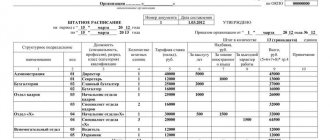How and when are changes made to the staffing table?
Changes in the staffing table occur in cases where the composition of employees changes, new departments are formed, old positions are eliminated and new ones are introduced. Changes are made in two main ways: you can completely replace the staffing table itself, or issue an order to make changes to the staffing table. In the event that changes to the staffing table are made on the basis of an order, the following reasons are indicated:
reorganization of the form;
optimization and improvement of the activities of governing structures;
all kinds of changes in legislation that require mandatory changes in staffing;
eliminating repetitive responsibilities;
reduction or expansion of a company's production.
When changes are made to the staffing table, adjustments must be made to the employee documents - work book and personal card (for example, when renaming a position). In this case, it is necessary to obtain the written consent of the employee.
When changing salaries (registration of allowances and bonuses), the employee must be notified in writing about this 2 months before the event. Changes of this kind are made not only to the staffing table, but also to the employment contract using an additional agreement to the contract. Also, do not forget that changes and additions made in the prescribed manner to the organization’s staffing table are brought to the attention of employees, after which appropriate changes and additions are made to their work books on the basis of an order (instruction) or other decision of the employer. This is stated in paragraph 3.1 of Instruction No. 69.
The material was prepared using legal acts as of April 17, 2015.
1.1. You can find out whether a company has a seal from its charter.
1.2. Whether there will be a seal on the contract still depends on the decision of the parties
1.3. Is it possible not to put a stamp on the power of attorney?
1.4. In what cases is it possible not to put a stamp, and in what cases is it obligatory?
2. For the HR officer: should I put a stamp when preparing documents?
2.1. The accident report may not contain the employer's seal.
2.2. How to certify entries in work books if there is no seal?
3.1. For organizations that have a seal, information about which is in the charter
3.1.1. What will happen to the costs if the counterparty does not have a seal?
3.2. For organizations that have a seal, information about which is not in the charter, as well as for newly created companies
3.2.1. What if the inspectorate does not accept reports without a seal?
3.2.2. What to do with reporting insurance premiums?
3.2.3. Is it necessary to certify with a seal copies of documents requested by the inspectorate during the inspection?
3.2.4. Is it necessary to put a stamp on the power of attorney of a representative of the organization?
3.2.5. Should an organization using CCP use a seal?
3.2.6. The obligation to affix a stamp when paying excise tax established in the Tax Code of the Russian Federation remains unchanged.
Is a stamp placed on the organization’s orders in 2020?
This:
- Powers of attorney related to the implementation of certain actions related to the expenditure of funds and material resources.
- (when starting it, dismissing an employee, or, for example, changing the employee’s last name).
- and copies of documents.
- Certificates of award, petitions, characteristics, recommendations, etc.
- Acts and letters of guarantee.
- Service and .
- Employment contracts (together with additional agreements to them and agreements on full financial responsibility).
- Local regulations of the organization.
- Educational materials are presented in the format of visual notes with video lectures by experts
- Ready-made document templates are available that you can
- Meets the requirements of the professional standard “Human Resources Management Specialist”
- For passing - a certificate of advanced training
To the lawyer: JSC and LLC will decide on their own whether to have a seal
1.1. You can find out whether a company has a seal from its charter.
From April 7, 2020, LLCs and JSCs are not required to have a round seal (Federal No. 82-FZ dated 04/06/2015, hereinafter referred to as the Law). Corresponding changes have been made, among other things, to the information about LLC and JSC.
From the same date, information about the presence of a seal must be contained in the company's charter. The absence of such information indicates that the legal entity does not have a seal. At the same time, destroy the seal if the named changes are not made to the charter or installed.
If a seal is required in accordance with the federal law, a seal impression, information about the presence of which is not in the charter, cannot be placed to fulfill the said requirement. However, there is no prohibition on the use of such a seal or liability for it.
Summary
Companies whose charter already contains information about the presence of a seal do not need to do anything. We recommend that other organizations include relevant information in their charter, since often the need to stamp documents is provided for by law or in an agreement between the parties. As for companies that are created after April 7, 2020, they have the right, but are not required, to have a seal.
Guide to corporate procedures: what risks should newly created LLCs and JSCs take into account when making decisions on the issue under consideration
1.2. Whether there will be a seal on the contract still depends on the decision of the parties
The sealing of contracts is still considered an additional requirement for their form.
Therefore, a seal on a contract is needed only if there is a corresponding indication in the law, other legal act or contract. This is confirmed by judicial practice. At the same time, a company’s refusal to use a seal may lead to difficulties in relations with counterparties for whom such execution of a transaction is decisive.
No less important is the question of whether it is necessary to put a stamp on acts confirming the execution of the contract by the parties (for example, on an act on the provision of services or on the completion of work), as well as on a receipt confirming the transfer of funds under a loan agreement. If the parties already have a seal and this is reflected in the charter, they can continue to use it when drawing up the listed documents.
Guide to contract work: recommendations for preparing the listed documents, taking into account the new
Summary
You may not put a stamp on the contract unless the counterparty objects and the law does not provide otherwise. Since the use of a seal when concluding a contract is an established practice for many companies, we recommend that you do not refuse to use the seal at least for the first time after the innovations come into force.
The online service “Contract Designer” will help you draw up an agreement taking into account the described innovations. A warning has already been added to the questionnaires (section “Final provisions”) and templates (section “Addresses and details of the parties”) for contracts for supply, contract, paid services, rental of non-residential premises, loans, as well as purchase and sale of vehicles, according to which the bonding the seal of the contract is not necessary, unless it is provided for by agreement of the parties, law or other regulatory legal acts. In addition, relevant judicial practice is provided.
1.3. Is it possible not to put a stamp on the power of attorney?
As of September 1, 2013, a seal ceased to be a necessary requisite of a legal entity’s power of attorney, as provided for by the Civil Code of the Russian Federation. A power of attorney on behalf of a legal entity is issued signed by its head (Civil Code of the Russian Federation). Previously, the obligation to put the organization's seal on a power of attorney issued on behalf of a legal entity was established in the Civil Code of the Russian Federation. The requirement for a seal remained for some types of powers of attorney, for example, for powers of attorney of procedural representatives.
At the same time, a seal is still needed, for example, in order to leave the pledged item under lock and key with the pledgor and the pledgee, as well as for educational documents for educational organizations.
Previously, in all cases it was required to certify this act with a seal. At the same time, the individual employer who did not have it had to certify his signature in the prescribed manner.
Summary
The procedure for drawing up a report on an industrial accident has been simplified for both individual employers and organizational employers. Now business companies that do not have a seal are not required to put one on this document.
The staffing table of the unified form T-3 is used to indicate the structure and personnel of the organization. Let's look at this form in more detail, and also provide a staffing table with a sample filling.
Vote:
You can make changes to the staffing table in the following ways: 1.
Changing the staffing table itself. It is more convenient to do this when the changes are significant.
In this case, the staffing table itself changes. A new one is issued with the next registration number and approved by an order for the main activity. The advantage of this method is that the current staffing table is clearly presented with all the latest changes.
2. When changes made to the staffing table are not significant, it is more convenient to make changes by issuing an order. For example, when salaries do not change, but the names of one or two positions have changed.
It is issued as an order for the main activity with a permanent shelf life with the wording:
“Make the following changes to the current staffing table...”
. This reduces document flow, since only an order for the main activity is issued.
The staffing table does not change.
All about the staffing table: what is it, why draw it up and who should draw up this document?
Free legal advice: All Russia » » » Staffing table Who signs the staffing table.
Is a stamp on the staffing table necessary or not? The staffing table is an internal document of the organization, which reflects:
- the names of all existing positions at the enterprise and the qualifications required to occupy them;
- salary amount (salary, rate, etc.);
- staffing levels, their number;
- allowances for each position (if available at the enterprise).
For the convenience of its administration, a unified form T-3 has been developed (OKUD 0301017).
However, the use of this form is not mandatory; it is recommended to use it, since it contains all the necessary details and relevant fields to fill out.
Staffing: unified form T-3
From January 1, 2013, commercial organizations are not required to draw up personnel documents according to approved forms, that is, they can use independently developed document forms.
For more information about this, see the article
“Primary document: requirements for the form and the consequences of its violation” .
However, the unified T-3 form is a fairly convenient and familiar way to draw up a staffing table. In addition, the staffing table of the T-3 sample form contains all the necessary information, so most employers continue to use this particular form of document.
Let us remind you that the staffing table - a form of the unified form T-3 - and the procedure for filling it out were approved by Decree of the State Statistics Committee of the Russian Federation dated January 5, 2004 No. 1. In order for users of our site to know how to draw up a staffing table, a sample document is presented in its pure form (in this section) and in the completed state (in the last section).
We compose as desired
Let us say right away that labor legislation does not contain a direct requirement for employers to draw up a staffing table. This means that whether or not to draw up a staffing table remains at the discretion of the company. That is, the management itself decides whether there is a need for staffing, or whether it can be done without it. However, despite the optionality, it is better to draw up a “staff”. After all, the staffing table contains complete information about the organization’s human resources and the monthly wage fund (Article 57 of the Labor Code of the Russian Federation, section 1 of the instructions, approved by Resolution of the State Statistics Committee of Russia dated January 5, 2004 No. 1).
For identical positions on staff, the same wages must be provided. The fact is that for equal work, the law requires equal pay (Article 22, Part 2, Article 132 of the Labor Code of the Russian Federation). If it is necessary to diversify the salaries of employees occupying the same positions, the safest thing would be to introduce the concepts “senior”, leading”, “assistant”, etc. into the T-3 form. For example, “senior cashier”. In addition, in employment contracts with employees, it is necessary to specify the various functions of employees in positions of the same name:
- different rights and responsibilities;
different levels of responsibility.
Another way to protect yourself from claims from inspectors is to introduce a special bonus for employees who are supposed to be rewarded.
It is clear that having a “staff” at your disposal, you can clearly see the structure of the organization and calculate the required amount of money for the maintenance of employees. It is clear that if there is a “staff”, company managers have complete information about the personnel when making management decisions that are important for the company.
If a positive decision is made on the “staff”, then the question of approving the document will inevitably arise. Do I need to put a stamp on the staffing table?
What information does the unified staffing form contain?
The staffing table is one of the internal regulatory documents that every organization (or entrepreneur with employees) must have.
The staffing table contains:
- list of structural divisions;
- names of positions, specialties and professions indicating qualifications;
- information on the number of staff units;
- information on salaries: tariff rates and salaries, bonuses, wage fund (payroll), including for the organization as a whole.
The main purpose of the staffing table is to determine the structure, staffing levels and size of the payroll. The document does not contain the names of employees and their staffing positions. The staffing arrangement (synonyms: staff replacement, staff list) is not established by regulatory documents. Staff replacement, unlike the staffing table, is not a mandatory document for the organization, however, it is often used. This is due to the fact that full-time replacement allows you to track vacancies, as well as the filling of staff positions when hiring a part-time employee or if the position is divided between several employees. Staff replacement is usually developed on the basis of the staffing table of the T-3 form with the addition of a column in which the last names, first names, and patronymics of employees occupying certain positions are entered. If an organization uses staff replacement in its activities, then it must be taken into account that this document must be stored for 75 years.
Read about the retention periods for personnel documents.
Who provides visas if there is no personnel service?
Lines intended for signatures can be left empty in two cases:
- if the positions of head of the personnel department and chief accountant are vacant;
- if the head of the organization independently maintains accounting records.
The staffing table is a very important regulatory document that allows you to painlessly regulate judicial issues if they arise (is it a local regulatory act?). Therefore, it is very important to compose and format it correctly.
How to properly draw up a staffing schedule
Drawing up the staffing table can be entrusted to any employee of the organization, and it must be approved by order (instruction) of the manager or other authorized person. The procedure for issuing documents on approval of the staffing table must be enshrined in the constituent documents.
Read about the nuances of drawing up such orders in the material “Orders for core activities - what are these orders?”
.
When drawing up the staffing table for the first time, it is assigned the number 1, and subsequently continuous numbering is used. The staffing table indicates the date of preparation, as well as the date from which the staffing table comes into effect. These two dates may vary. Form T-3 provides an indication of the period of validity of the staffing table, details of the order for its approval and the number of staffing units.
Region: Russian Federation
The staffing table is a special document that formally establishes the structure of the organization, its composition and number of personnel. It indicates what positions the company has, what qualifications are required for these positions, how many staff positions are provided for each of them, what salaries (bonuses, allowances) apply.
You can prepare a sample staffing schedule yourself. However, for convenience, Goskomstat has developed a standard (unified) form T-3. It is not mandatory for use, but, as a rule, it is what most enterprises use in their work. The T-3 form is convenient, practical and familiar to many personnel officers and accountants.
Code of the structural unit in the staffing table and other information
The staffing table in the tabular section begins to be filled out by indicating the names and codes of structural divisions. As a rule, the department code in the staffing table is indicated in an order that allows one to determine the subordination and structure of the entire organization.
If an organization has branches and representative offices, then it must be taken into account that they are a structural unit of the organization, and accordingly, the staffing table should be drawn up for the organization as a whole. Even if the head of the branch has been given the right to independently approve the staffing table, it is still drawn up as part of a single staffing table.
Column 3 of the staffing table contains the name of the position, specialty, profession, which are indicated in the nominative case without abbreviations. The name of the position or profession is assigned by the employer, if the work is not associated with difficult working conditions and the provision of benefits, otherwise, when indicating the position in the staffing table, you need to be guided by:
- for the All-Russian Classifier of Worker Occupations, Employee Positions and Tariff Classes (OK 016-94) (approved by Resolution of the State Standard of Russia dated December 26, 1994 No. 367);
- All-Russian Classification of Occupations (OKZ) OK 010-2014 (MSKZ-08) (approved by order of Rosstandart dated December 12, 2014 No. 2020-st);
- Qualification reference book for positions of managers, specialists and other employees (approved by Resolution of the Ministry of Labor of Russia dated August 21, 1998 No. 7);
- unified tariff and qualification directories of works and professions of workers by industry;
- professional standards (paragraph 3, part 2, article 57, article 195.1 of the Labor Code of the Russian Federation).
Read how to bring job titles into line with professional standards.
If an organization hires employees to perform a certain type of work, and not for a position (profession, specialty), then this also needs to be reflected in the staffing table.
Next, in column 4 of the staffing table, the number of staff units is indicated. Staffing units can be indicated as full or incomplete. The content of an incomplete staff unit in the staffing table is indicated in shares, for example 0.25; 0.5; 2.75, etc.
When drawing up the staffing table, special attention should be paid to column 5 “Tariff rate (salary), etc., rub.” In the simplest case, this column of the staffing table indicates a fixed monthly wage.
In practice, when drawing up a staffing table, the question often arises about the correct execution of the document in situations where there is no fixed amount of remuneration, for example, with piecework payment. In this case, it is recommended to put a dash in column 4 of the staffing table, and in column 10 indicate: “Piece-piece wages / Piece-piece bonus wages” and provide a link to the local regulatory act that defines the procedure for establishing wages, as well as its amount for a certain standard production. It is recommended to follow a similar procedure when filling out the staffing table in a situation where the employee has an hourly wage rate.
If the staffing table provides for an incomplete staffing position, then in the column “Tariff rate (salary)” the amount of the full salary for the position is still indicated.
How to fill out a staffing table: sample and example
A sample of filling out the staffing table of Form T-3 in a situation where there is no fixed salary, and there is also an incomplete staffing position, can be found on our website.
NOTE! In Art. 22 of the Labor Code of the Russian Federation states that payment should be equal for equal work. It follows from this that the “fork” of salaries in the staffing table is a violation of the Labor Code. Rostrud, in letter No. 1111-6-1 dated April 27, 2011, recommends that the same salary amounts be indicated in the staffing table for positions of the same name, and that the possibility of paying one of the employees wages (not salary) in a larger amount should be regulated through allowances and additional payments depending on the complexity work, quantity and quality of labor.
In columns 6, 7, 8 “Additional allowances, rub.” allowances are indicated - both accepted in the organization (for long working hours, increased responsibility, knowledge of foreign languages, work experience, etc.) and established at the legislative level (for example, for work in the Far North). The staffing table of the unified form assumes that these columns are filled in in rubles. If there are not enough columns to indicate all the allowances in force in the organization in the staffing table, then their number can be increased by issuing an order to supplement the staffing table form. It is recommended to do the same if the premiums are set as a percentage.
Column 9 “Total for the month” is filled out only if the salary and allowances are indicated in rubles. The instructions for drawing up the staffing table state that “if it is impossible for an organization to fill out columns 5-9 in ruble terms... the columns are filled in in the appropriate units of measurement (percentages, coefficients, etc.).” However, it is impossible to actually formalize the staffing schedule in this way. In such a situation, you can put dashes in this column, and in column 10 “Note” indicate a link to regulations, both internal and regulatory, that establish premiums. The link in column 10 to the document allowing you to set an increase for length of service will allow you not to change the schedule when the amount of the increase changes. Column 10 also indicates any information related to the staffing table.
Whose signatures should be on the document?
So the decision whether to have staffing or not is really yours. And our further recommendations for those who answered yes to this question.
To prevent disputes with the employee, before you sign the employment contract, inform him whether the organization uses a seal or not. If he asks, familiarize him with the documents that confirm this. Additional printing is used for structural units and certain types of documents. For example, with the seal “For the HR Department,” the head of the department will be able to certify the authenticity of the signature on personnel documents. The stamp “For copies”, “For documents” certify copies of documents, extracts from them, and certificates. An organization may have other types of additional seals.
After such an action, a separate order is issued approving the already changed schedule. This scheme is standard and may look slightly different depending on whether the position is vacant at the time of renaming or not and whether there is consent from the employees to such an action.
This column determines the salary established for a full-time employee. It must be remembered that the law allows for a single salary for each position.
In a medium-sized and, especially, a large company, HR reports are such that the standard staffing table, as they say, is not even close. So think for yourself: should you have a staffing table or not. I answer like this: “In our organization there is no such document!”
The employer has the right to have a main seal and additional ones, for example, “For the HR department”, “For documents”, stamps, or work without a seal.
But in commercial companies operating for profit, the most important thing is to save and control. If the company is small, then the manager knows by name who works, how and for what.
In HR work, there are documents in which the main seal of the organization does not need to be affixed, so for convenience, employers approve a special seal for the HR department. This makes things easier for HR officers: they don’t wait for the manager to certify an important document, but draw it up themselves.
Documents are registered once: received - on the day of receipt, created - on the day of signing or approval. When transferring a document from one department to another, a new registration number, as a rule, is not affixed to the document.
Nuances of registration and changes to the staffing table
The unified form T-3 requires the signatures of the head of the personnel service and the chief accountant, but it does not contain such requisites as a seal. The frequency and timing of approval of the staffing table are not established by law, and each employer decides this issue independently.
Familiarization with the staffing table of employees is carried out only if this obligation of the employer is secured by a collective agreement, agreement, or local regulatory act (letter of Rostrud dated May 15, 2014 No. PG/4653-6-1).
Changes may be made to the staffing table if it is necessary to supplement it with new positions and structural divisions or, conversely, to exclude them, as well as when changing salaries, renaming departments and positions. Changes in the staffing table are formalized by order. There are 2 ways to make changes to the staffing table:
1) issuing an order on the corresponding change;
2) issuance of an order approving a new staffing table.
When reducing staff or numbers, or changing salaries, changes are also made to the staffing table, but it must be taken into account that the date of entry into force of the changes cannot occur earlier than 2 months after the issuance of the order. This is due to the fact that employees must be notified 2 months in advance about the upcoming layoff (Part 2 of Article 180 of the Labor Code of the Russian Federation) or about upcoming changes in the terms of employment contracts.
The staffing table is kept permanently in the organization. Organizations carrying out control and supervisory functions (for example, the labor inspectorate, regulatory bodies of the Federal Social Insurance Fund of the Russian Federation, the Pension Fund of the Russian Federation, tax authorities) have the right to request this document when conducting inspections. In case of failure to provide the documents or copies thereof requested by the controllers, including the staffing table, the employer may be subject to a fine of 200 rubles. for each document not submitted (clause 1 of Article 126 of the Tax Code of the Russian Federation).
Signing and approval
After work on the “staff” is completed, the document must be signed by the chief accountant and the head of the personnel department. In general, signatures are placed at the end of the document. However, if the document takes up more than one page, then each sheet of the schedule can be endorsed.
After signing the document, it must be approved by the head of the organization by his order (section 1 of the instructions, approved by Resolution of the State Statistics Committee dated January 5, 2004 No. 1). Is it necessary to put a stamp on the staffing table?
Labor relations are an agreement between an employee and an employer (organization or individual entrepreneur) to perform work specified in the contract for payment. During work, the employee is under the management and control of the employer, obeys the internal labor regulations and works in the interests of the employer (Article 15 of the Labor Code of the Russian Federation).
The answer to the question whether it is necessary to put a stamp on the staffing table (form T-3) is negative. The fact is that form No. T-3, approved. Resolution of the State Statistics Committee dated January 05, 2004 No. 1 does not provide for affixing a seal to the staffing table approved by the head of the company. There is no space provided for printing on the unified form.
A self-developed form is another matter. If it provides for the application of a seal, then the answer to the question of whether it is necessary to put the organization’s seal on the staffing table will be in the affirmative.
If you find an error, please select a piece of text and press Ctrl+Enter.
At the same time, the approximate form of the contract, approved by Resolution of the Council of Ministers of the Republic of Belarus dated 08/02/1999 No. 1180 (as amended on 01/19/2012), does not contain the “Seal” requisite. Entries in the employee’s work book that are subject to certification with a seal The first page (title page) of the work book, containing the listed information about the employee, is certified by the signature of the employer or an authorized official and the seal of the employer, and if the individual entrepreneur does not have one, by the seal of the local executive and administrative body who registered an individual entrepreneur (part two of clause 18 of the Instruction on the procedure for maintaining work records of employees, approved by Resolution of the Ministry of Labor of the Republic of Belarus dated 03/09/1998 No. 30 (hereinafter referred to as Instruction No. 30)).







